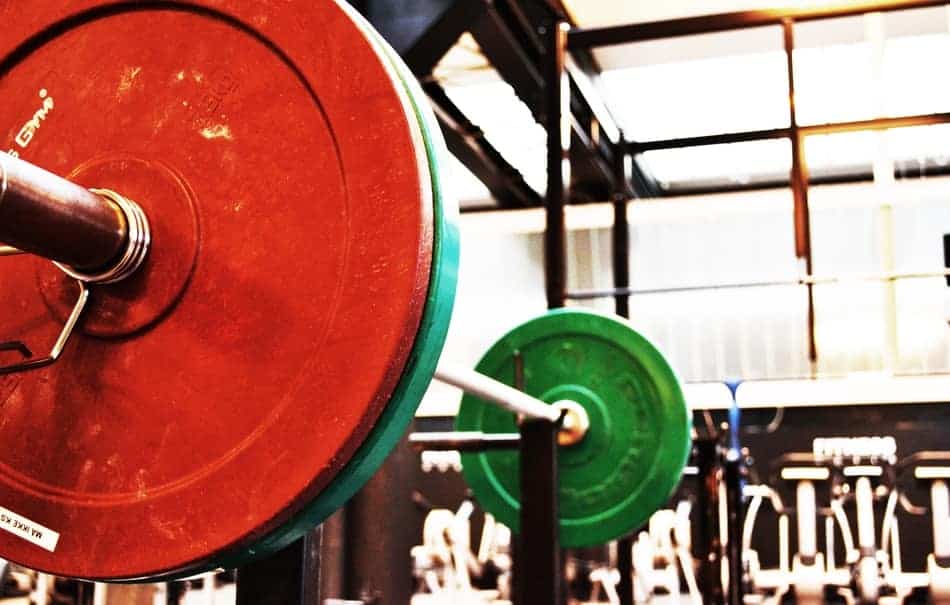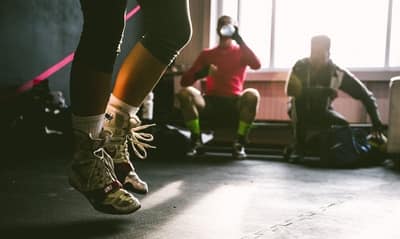
When it comes to the sweet science of boxing, there has always been a topic that has been controversial among fighters, and that is weightlifting. To be more specific, many fans and boxers alike wonder if lifting weights is going to make a better boxer or not? This is something that I wondered for years. But after talking to several different pro boxers and trainers, I got the definite answer for you:
Bodybuilding-style weightlifting is generally not a good idea for most boxers. And there are many reasons for this, but one of them is the fact that it tends to make the boxers slower, bulkier, and it tires their muscles more quickly, which is exactly what they don’t want in a boxing match.
However, it’s important to keep in mind that while this will hold true for most types of weight training, there are some exercises that can actually help you improve your performance in the ring. The problem is that most boxing enthusiasts are simply doing bodybuilding style workouts that make them big but won’t really help them create functional strength that they can bring into the ring.
In other words, you could lift weights, but you really need to know what you are doing in order to reap the benefits of the practice. You should avoid doing any kind of bodybuilding style lifts or routines and instead focus on exercises that will develop explosive power that will play in the ring. Heavy bench presses & pushdowns are out, weighted abs, oblique, & functional strength work is in.
If you do it correctly, proper weightlifting you could give you an advantage in the endurance and power department, and you could surprise your fellow boxers in the ring. But again, it’s important that you do the correct exercises, in the correct rep range, with the correct intensity, or else you are just slowing yourself down.
Also if you want to become good at boxing your main focus should be improving your technique through exercises such as shadow boxing, bag work, pad work and gaining experience in the ring through sparring. You should spend no more than 20% of your training time for conditioning (including weightlifting, running, swimming etc). The rest 80% should be focused only on technique.
Below, I will talk a little bit more about this topic, including a comprehensive list of the pros & cons of weightlifting, which exercises are the best for boxers, and a list of fighters who weight train as part of their training regime.
To see a proper boxing workout routine + strength and conditioning check out this article: The Best Boxing Workout for Beginners (More than 50 Drills) after you finish reading this one.
What Are The Pros & Cons Of Weightlifting For Boxers
As I said above, I talked to several boxers and trainers on the matter, and it seems that the issue isn’t as black and white as most people think. Many of them didn’t think boxers should be lifting weights very often, and there were some others that actually spoke highly of the practice. Some others had a more mixed opinion of it.
What I personally got from talking to all of them is that boxing has its pros & cons, and these will vary depending on what kinds of lifts you are doing. Below, I provide a table indicating the pros & cons of regular weight lifting in a training regimen.
| PROS | CONS |
| ✔ Will develop your explosive power ✔ Some exercises could greatly assist you at pulling your punches back faster ✔ Good way to treat nagging injuries ✔ Great way to make abs more conditioned to withstand punches | ✔ Could make you bulkier, slower, and more tired in the ring ✔ Spending more time lifting weights means that you are spending less time in actual boxing drills. ✔ Increased risk of injury when done wrong |
The pros above will only apply to proper weightlifting with the right exercises. Boxers should limit isolation lifts as much as possible (tricep pushdowns, bicep curls) because these exercises tend to be used mostly for bulking purposes plus they make the muscles they target stiffer. Plus the movement itself doesn’t really translate to the boxing ring at all.
Anyways, below are the most important pros & cons of regular weightlifting for the average boxer.
Weightlifting can develop your explosive power
This is perhaps the main reason why boxers lift weights in the first place: It promotes explosive strength. As you probably know already, throwing a decent punch requires the whole body to move in a coordinated fashion, starting from the leg movement, moving up to the core, and finishing in the arm delivery. The result is a snappy punch that will make heavy bags scream and opponents grunt. Many boxers strive to make their punches as powerful as possible, and weightlifting is something that can definitely help you with that.
The exercises that are most going to help you improve your explosiveness are compound lifts. We are talking about things like bent-over rows, snatches, pull-ups, etc… Also, it’s essential that you add some abs and oblique work to your weightlifting routine. It’s one of the best ways to really make your punches more snappy. I mean just think about it: most of the power is generated by your core, which includes the abs, obliques, and a few other minor muscles near your trunk, and so strengthening those muscles will really make a dramatic difference in how hard you hit.
However, as I said above, it’s important to make sure you focus on building strength rather than muscle. Ideally, you are going to want to work out in the low rep range. That is, under 6-8 reps per set. This rep range has been shown to promote strength gains without adding as much bulk as with training in more moderate rep ranges.
Weightlifting Could Make You Bulkier And Slower
Just as lifting weights can make you a more explosive athlete and your punches more snappy, it can also make you slower and stiffer too. There have been many times that I have seen these huge muscled up guys that will do a number on the heavy bag, but they can’t touch anybody decent in a sparring session because they are so damn bulky and slow. Big muscles mean a lot of weight to carry around which makes it harder to throw a technically sound punch.
Plus, many boxers feel like your muscles get tired much more quickly when you lift weights, myself included. I used to blast my shoulders with a whole bunch of exercises without knowing that when it comes to boxing, less is more. I thought that heavy weight training would improve the snap of my jab, and it did actually, but after a few rounds of bag work they felt really heavy and spent, just like I had never boxed before. My biceps also tend to feel very tight if I overwork them at the gym, and my body overall tends to feel stiffer after training generally.
So again as I said above, if you are an aspiring boxer and like doing bodybuilding style routines in the weight room, then you need to replace that for a more functional routine that will target strength gains rather than muscle. This means avoiding 8-12 rep ranges, focusing on explosive contraction, and avoiding spending too much time in the weight room. As a general rule, focus on heavy compound exercises that target more than 1 muscle group.
Great way to make abs more conditioned to withstand punches
This is another very overlooked pro of weightlifting: it’s going to promote a stronger, more resistant core that will not only improve your punching power, but it’s a great way to improve the resistance of the area, so that body punches have less of an effect on you. In fact, I think that the most important kind of weight lifting you should be doing are weighted ab exercises because of this.
Every boxer and boxing fan is aware of the fact that sometimes the waist of the average boxer is a little bit blockier and bulkier than that of the athletes of other disciplines. The reason for this is that boxing is an activity that demands a lot of core activation when punching and ducking. Ab exercises like sit ups and crunches are also super common to improve the conditioning of this body part.
The result a stronger, bulkier core as you would assume, but what most people overlook is that it will also seriously improve your ability to take a punch down there. I personally hate getting hit by body shots because they disrupt my rhythm plus they tend to tire me. Because of this I personally focus a lot of core exercises to improve the ability of my body to withstand punches. I usually do the usual sit ups and crunches, but I also like to take those exercises a bit further and combine them with weights to make my core as rock solid as possible.
Training the core with heavy weights is something done by a lot of pro boxers and I recommend that you do so too. Aside from the classic medicine ball exercises, you should also start doing exercises like ab pulldowns, cable woodchoppers, and weighted oblique twists with a weighted ball, making sure you focus on form and trying to use heavier weights than usual. The result is a stronger core with an improved ability to take a punch.
Increased risk of overtraining and injury
Proper weightlifting can certainly be a positive addition to a boxer’s regime when done right, but one of the biggest cons I must talk about is the fact that weightlifting can increase the risk of overtraining in a boxer, and even worse, it could even contribute or cause a serious injury.
This is often seen in boxers who start weight lifting too hard too soon. Lifting weights is very stressful for the body, especially if the trainee doesn’t have much experience with that kind of exercise. In short, weightlifting can definitely help you become a better boxer, but you must be careful with how hard you go when first starting, especially if you are already immersed in an intense boxing routine.
Overtraining refers to the phenomenon of exceeding the body’s capacity to recover from intense training. In other words, it refers to over pushing your body beyond its capacity, and it’s something boxers need to be cautious of. This is because boxing is very taxing on your body, so if this is your case and you are busting your butt every time that you get into the gym, it might be wise to avoid weightlifting too hard.
Ideally, you should start weightlifting no more than 2 times a week. After that, your body itself will be the best guide to infer whether you should increase the frequency of the weight lifting or not. If you feel like you can keep up with a more intense weight regime, then go ahead and lift weights more often, but if you feel like you are overtaxing your body, then it might be wise to hold back a little bit.
Also, when weight lifting (especially lifting with improper form), there’s always the chance that you could injure a major body part or joint. This is very common in overconfident lifters who think they can increase weight without having the form down. I’m all about heavy, strength-focused weight training, but it’s also a double-edged sword because of this.
If you aren’t very experienced with weight lifting, it’s always a good idea to go with a buddy so that you can get assistance or if possible, talk with one of the trainers in the gym. Again, listen to your body. If you feel like you can’t do a lift without breaking proper form for more than a few reps, then it might be wise to try lowering the weight of the exercise you are doing.
These are just some of the pros & cons of weightlifting for boxers. I personally would advise that you disregard anybody that says that lifting weight is bad for fighters. It isn’t as black and white as most people think. Sure, it might make you (a bit) slower, but you gain so much punching power from a proper weight lifting routine it’s not even funny.
Anyways, as I said above, not all exercises will serve you in your quest to become a better boxer. Some are just going to slow you down and bulk you up. Below, I provide the best lifting exercises you should be doing that will help you gain an edge over your opponents!
Lifting Exercises you Can do
Woodchoppers/Axe Chops
Targeted Body Part: Core
This exercise is number one for a reason: it’s among the best moves to improve your core strength and explosiveness! As the name implies, this exercise consists of simulating you are chopping a tree with an ax. You are going to use both hands to grab the handle and then you are going to rotate your core hard, pulling the cable in the process.
You could do this exercise either with a cable machine or with a resistance band, and it’s highly recommended that you do this with enough weight that the exercise leaves you winded after 8 reps. Try doing 3 sets of no more than 8 reps in quick succession for best results. Avoid doing this exercise with light weights and make sure you twist your torso explosively as if you were to cut a tree with an axe.
This is among the very best weight exercises to improve your punching power. If you do this correctly, expect power gains in as quickly as a few weeks. Just like medicine ball throws, this is a very effective exercise because it mimics the actual motion of a punch, and unlike many other weight exercises, this one is very unlikely to give you much, if any bulk.
Bent-Over Row
Targeted Body Part: Back
Another great exercise that any boxing weight lifting routine should have is the bent-over row. While you could do rows in machines, I always recommend boxers to do the free weight version of the exercise because it doesn’t restrict your range of motion, which is exactly what a boxer doesn’t want. Using free weights also has the added advantage of working supporting muscles that machines do not target at all, making it a more helpful exercise.
This exercise consists of bending down, grabbing a barbell or dumbbell, and pulling it up to the stomach while still in a bent position. If properly done, you should feel your back tightening. After you bring the barbell/dumbbell to your stomach, you are going to bring it down without letting it touch the floor. I personally do 3 sets of 6-8 reps.
I’m a big fan of this exercise because it helps you control your arms in a more efficient way. The Latissimus Dorsi is the muscle responsible for adduction of the arm, which is just a fancy way to say that it pulls things into your body. In other words, a stronger back will help you bring your punches back faster to a defensive position, allowing you to either block the enemy’s punches or rip a new combination.
Snatch
Targeted Body Part: Shoulders, Core and Legs
Not just for cross-fitters & circuit trainees, the snatch is a very useful exercise for developing the explosive strength that is so crucial in boxing. In fact, this is perhaps one of the most efficient exercises at doing so. Because the exercise is so complete, you only need to do a few reps to really reap the benefits of it. And best of all: this exercise isn’t exactly known as a muscle builder, keeping you quick and light while at the same time making you a more fearsome puncher.
Also, this exercise is excellent for developing your stability and mobility. Aside from your punching power increasing, expect your balance to improve after a few weeks of doing this move. Now, for this exercise I would personally recommend that you get somebody to teach you proper form because it’s actually pretty difficult to do properly. It’s the only bad thing about it, but if you can master it, this exercise could really make you a more complete boxer.
These are just some of the most useful weight exercises out there that will really make a difference in your performance inside the ring. I would personally recommend that you add these to your existing routine if you have one. They are the best because they will seriously improve your functional strength while not slowing you down as much as more conventional lifts.
How Often Should You Lift Weights?
Many fighters tend to have the exercise selection part down, but they aren’t sure how often they should be doing the exercises though. And the answer is that it really depends on how hard you are going to the boxing gym. If you are pro/amateur boxer and you currently training for a bout, then there’s a big chance that you are giving your all at the gym every time that you go, leaving you exhausted. Combine this with ample amounts of roadwork and you have a recipe for overtraining.
If the above example applies to you, then I would personally recommend that you weight train no more than 2 times a week, 3 tops. This way you avoid spending all of your energy on it, allowing you to stay focused on what matters the most: the actual boxing drills & exercises.
However, if you aren’t training as intensely (not preparing for a fight), then you could go ahead and weight train a little bit more frequently. Again as I said above, It’s important to make sure you listen to your body. If you are finding yourself more winded at the boxing gym after a vigorous weight lifting session, it might be wise to reduce the frequency of your trips to the weight room, at least for a few weeks.
Examples Of Boxers Who Lift Weights When They Prepare For A Fight And Which Exercises They Do
- Tyson Fury: The Gypsy King likes incorporating weight lifting to his training camp. He has been spotted doing traditional lifts like bench presses, deadlifts, and shoulder presses. And It seems that they aren’t slowing him down at all. Fury is after all unusually fast for a heavyweight, it is maybe because of doing these exercises?
- Adrian Broner: Everybody seems to hate Broner, so I won’t talk about him much, but he’s well known for incorporating traditional lifts to his training camp. He has been found doing bench presses, bicep curls, and shoulder presses. Broner is a complete clown though. Maybe he’s not doing it to actually have an advantage in the ring, but to just look better. Who knows.
- Miguel Cotto: This Multiple time Puerto Rican world champion is no stranger to weightlifting. This now-retired Puerto Rican star has been spotted doing military presses, axe chops, weighted core work, and medicine ball work. It seems that Cotto dislikes doing traditional weightlifting though. He has never been seen doing things like bench presses or tricep pushdowns.
- Anthony Joshua: Joshua is super ripped, and maybe it’s because of all the weights he lifts. Just like the Gypsy King above, he has been spotted doing bench presses, deadlifts, and he also likes working with heavy medicine balls.



